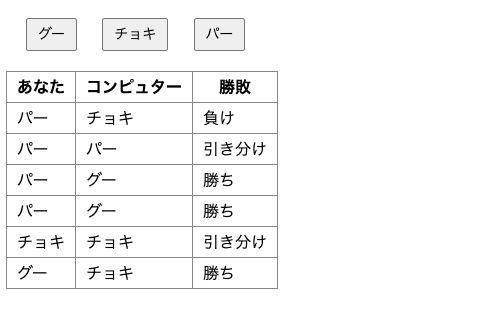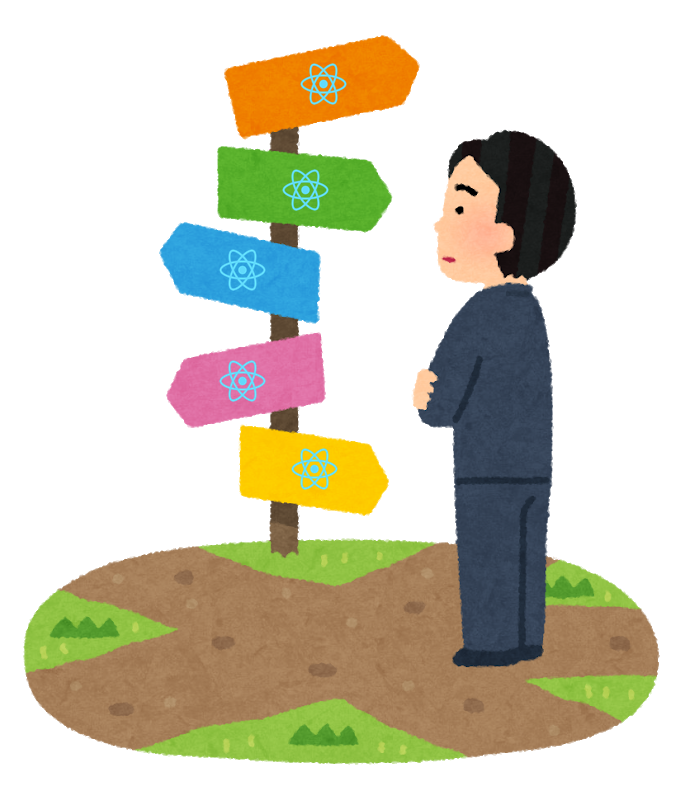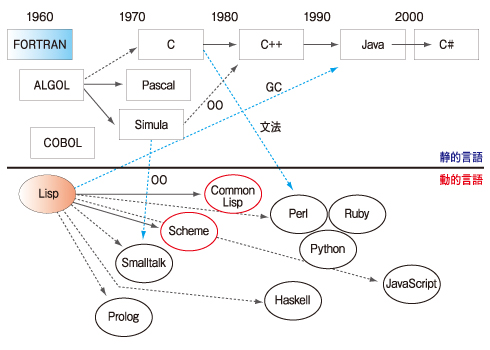今更ながらWeb Componentsを学んでみた(1) の続きです。今回Web Components構築ライブラリー Lit を使っていつものジャンケンアプリを作ってみました。
 Bing Image Creatorが生成した画像を使っています
Bing Image Creatorが生成した画像を使っています
HTML Templatesに付いて
前のブログでWeb ComponentsのHTML Templatesが理解できてないと書きましたが、その後に学びました。
<temprate>タグでHTMLの集まりを括る事で、その集まりをテンプレートととして再利用できるようになる- テンプレートの利用にはJavaScriptのコードを書く必要がある
- テンプレート中の
<slot>タグを、テンプレート利用時のslot属性でカスタマズできる
ReactのJSXや各種Webフレームワークにあるテンプレートとは異なり、条件分岐や繰り返しのような機構はありません。動的にHTMLを作成するにはJavaScriptでのDOM操作が必要になります。
いつものジャンケンアプリをLitで作ってみた
HTML Templatesを使うのは諦め、前のブログ で紹介した Lit を使って下図のいうなジャンケンアプリを作る事にします。

まず、前のブログ で説明したLitの知識だけで、書いたものが以下のコードになります。
- ① Reactのステートに相当するリアクティブ・プロパティ、ジャンケン結果オブジェクト
{human: 人間の手, computer: コンポーネントの手, judgment: 勝敗}の配列です - ② ジャンケンを行った際にはジャンケン結果を
this.scores配列に連結しています - ③ コンポーネント内のCSS定義はcssタグ付きテンプレートで定義し
styles変数に代入します - ④
@click=はジャンケンボタンのクリックのイベントハンドラーです - ⑤
this.scoresの内容表示の繰り返し部分はmap関数を使い作ります。Reactと同じですね❗
<!DOCTYPE html>
<html lang="ja">
<head>
<meta charset="UTF-8">
<meta name="viewport" content="width=device-width, initial-scale=1.0">
<title>Counter</title>
</head>
<body>
<script type="module">
import { LitElement, html, css } from "https://esm.sh/lit";
class JyankenElement extends LitElement {
static properties = {
scores: {type: Array} // ← ①
};
constructor() {
super();
this.teString = ["グー","チョキ", "パー"];
this.judgmentString = ["引き分け","勝ち", "負け"];
this.scores = [];
}
pon(human) {
const computer = Math.floor(Math.random() * 3);
const judgment = (computer - human + 3) % 3;
const score = {human, computer, judgment};
this.scores = [score, ...this.scores]; // ← ②
}
static styles = css` <!-- ← ③ -->
table {
border-collapse: collapse;
}
td, th {
border: solid 1px #888; padding: 3px 10px;
}
.jyanken_box {
margin: 20px 10px;
}
button {
margin: 0 10px; padding: 4px 10px; font-size: 14px;
}
`;
render() {
return html`
<div class="jyanken_box"> <!-- ↓ ④ -->
<button @click=${() => this.pon(0)}>グー</button>
<button @click=${() => this.pon(1)}>チョキ</button>
<button @click=${() => this.pon(2)}>パー</button>
</div>
<table>
<thead>
<tr>
<th>あなた</th>
<th>コンピュター</th>
<th>勝敗</th>
</tr>
</thead>
<tbody>
${this.scores.map((scrore) => html` <!-- ← ⑤ -->
<tr>
<td>${this.teString[scrore.human]}</td>
<td>${this.teString[scrore.computer]}</td>
<td>${this.judgmentString[scrore.judgment]}</td>
</tr>`
)}
</tbody>
</table>
`;
}
}
customElements.define("jyanken-element", JyankenElement);
</script>
<jyanken-element></jyanken-element>
</body>
</html>
コンポーネントの分割
さて、ここで結果表示、ボタン、メインのコンポーネントに分けてみましょう。Litはここでも便利な機能を提供していますね。
結果表示コンポーネント
結果表示はジャンケン結果の配列を受け取る必要があります、getAttribute()メソッドを使って受け取る事もできますが、文字列しか渡せません。そこでLitではリアクティブ・プロパティに独自のプロパティ(Props)を渡す事ができます。
このcores-elementコンポーネントに引数を渡すにはドットから始まるプロパティを使います → Property expression
<cores-element .scores=${this.scores}></cores-element> のように書きます。
class ScoresElement extends LitElement {
static properties = {
scores: {type: Array}
};
constructor() {
super();
this.teString = ["グー","チョキ", "パー"];
this.judgmentString = ["引き分け","勝ち", "負け"];
}
static styles = css`
table {
border-collapse: collapse;
}
td, th {
border: solid 1px #888; padding: 3px 10px;
}
`;
render() {
return html`
<table>
<thead>
<tr>
<th>あなた</th>
<th>コンピュター</th>
<th>勝敗</th>
</tr>
</thead>
<tbody>
${this.scores.map((scrore) => html`
<tr>
<td>${this.teString[scrore.human]}</td>
<td>${this.teString[scrore.computer]}</td>
<td>${this.judgmentString[scrore.judgment]}</td>
</tr>`
)}
</tbody>
</table>
`;
}
}
customElements.define("scores-element", ScoresElement);
ボタンコンポーネント
このコンポーネントもプロパティでコールバック関数を受け取っています。リアクティブ・プロパティの型はFunctionになります。
class ButtonsElement extends LitElement {
static properties = {
pon: {type: Function}
};
constructor() {
super();
}
static styles = css`
div {
margin: 20px 10px;
}
button {
margin: 0 10px; padding: 4px 10px; font-size: 14px;
}
`;
render() {
return html`
<div>
<button @click=${() => this.pon(0)}>グー</button>
<button @click=${() => this.pon(1)}>チョキ</button>
<button @click=${() => this.pon(2)}>パー</button>
</div>
`;
}
}
customElements.define("buttons-element", ButtonsElement);
メインコンポーネント
メインのコンポーネントは<buttons-element>、<scores-element>コンポーネントを呼出す事でスッキリしました。
どちらのプロパティともにドットから始まるLitの拡張機能を使います。
- ① このコンポーネントのリアクティブ・プロパティはステートのみで使っているので
state: trueを指定しています - ② Reactのクラスコンポーネントと同様に関数引数には
.bind(this)が必要になります(面倒ですね)
class JyankenElement extends LitElement {
static properties = {
scores: {type: Array, state: true} // ← ①
};
constructor() {
super();
this.scores = [];
}
pon(human) {
const computer = Math.floor(Math.random() * 3);
const judgment = (computer - human + 3) % 3;
const score = {human, computer, judgment};
this.scores = [score, ...this.scores];
}
render() {
return html` <!-- ↓ ② -->
<buttons-element .pon=${this.pon.bind(this)}></buttons-element>
<scores-element .scores=${this.scores}></scores-element>
`;
}
}
customElements.define("jyanken-element", JyankenElement);
まとめ
Lit を使うとReactを書くように簡単にWeb Componentsが書けます。
今回はめずらしくTypeScriptではなくJavaScriptで書いていますが、モダンな開発環境も使っていません。ライブラリーもCDNからインポートしています。
SPA(Single Page Application)でフロントエンドを作るならLitではなく、ReactやVueを使うと思います。
しかし、従来jQueryを使って書いていたような便利機能を作るのには、Litは良い選択肢たど思いました。









